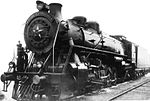Soviet locomotive class FD
| Soviet locomotive class FD | |||||||||||||||||||||||||||||||||
|---|---|---|---|---|---|---|---|---|---|---|---|---|---|---|---|---|---|---|---|---|---|---|---|---|---|---|---|---|---|---|---|---|---|
 Locomotive FD20-1237 at Brest Railway Museum | |||||||||||||||||||||||||||||||||
| |||||||||||||||||||||||||||||||||
| |||||||||||||||||||||||||||||||||
| |||||||||||||||||||||||||||||||||
| |||||||||||||||||||||||||||||||||
The Soviet locomotive class FD (Russian: ФД; Ukrainian: Паровоз ФД, romanized: Parovoz FD) was a Soviet main freight steam locomotive type named after Felix Dzerzhinsky (Russian: Феликс Дзержинский; Ukrainian: Фелікс Дзержинський, romanized: Feliks Dzerzhynskyi). Between 1932 and 1942, 3213 FD series locomotives were built.
History
The locomotive was created in connection with the industrialization conducted in the USSR. Planning took only 100 days, and typical construction time was 170 days. For certain features the design engineers referred to American practice in steam locomotive design. The first locomotive was built at the October Revolution Locomotive Factory in Luhansk, Ukrainian SSR (Luhansk, Ukraine) in 1931 and sent for a show to Moscow.

Tests, in which the locomotive performed well, were conducted in 1932. In that year the Luhansk October Revolution plant began mass production of FD20 locomotives. Over the course of production their construction got better steadily. From the beginning of the Great Patriotic war in 1941, production was interrupted only in 1942; four locomotives were built in Ulan-Ude, Russian SFSR. Total production was 2927 locomotives of FD20 and 286 locomotives of FD21. The two subclasses only differed in the type of superheater.
The locomotives of FD operated in areas with high turnover of goods. They worked on 23 of 43 railways in the USSR, including in Siberia and in the Urals. From middle of 1950, in connection with conversion to diesel engines and electric locomotives, the locomotives of FD began to be pushed aside from work. Also in 1958–1960 about 1000 locomotives were transferred to China, as China Railway class FD; some of these were subsequently transferred from China to North Korea,[1] where the Korean State Railway numbered them in the 8500 series.
Gallery
- Russian locomotive class FD 21-3125 at Moscow Railway Museum at Rizhsky Rail Terminal
- Russian locomotive class FD-1103 (on the left of the photo) at the Russian Railway Museum, St. Petersburg
- FD 20-1103 at Varshavsky Rail Terminal, St. Petersburg
- FD20-2
See also
- Russian Railway Museum, St.Petersburg
- The Museum of the Moscow Railway, at Paveletsky Rail Terminal, Moscow
- Rizhsky Rail Terminal, Home of the Moscow Railway Museum
- Finland Station, St.Petersburg
- History of rail transport in Russia
References
Notes
Literature
- В.А. Раков. Локомотивы отечественных железных дорог 1845-1955. — 2-е, переработанное и дополненное. — Москва: «Транспорт», 1995
- Справочник по локомотивам железных дорог СССР. Главное управление локомотивного хозяйства МПС. Трансжелдориздат 1956
- Курс паровозов. Устройство и работа паровозов и техника их ремонта (под редакцией С.П. Сыромятникова), Трансжелдориздат (State Publishing House), 1937
External links
- "Феликс Дзержинский" (Товарный паровоз серии ФД20) (in Russian). ZDRus. 1976. Retrieved 2009-06-26.
- "Zx6.ru" Паровоз серии ФД. История российских паровозов (in Russian). Retrieved 2009-06-26.





